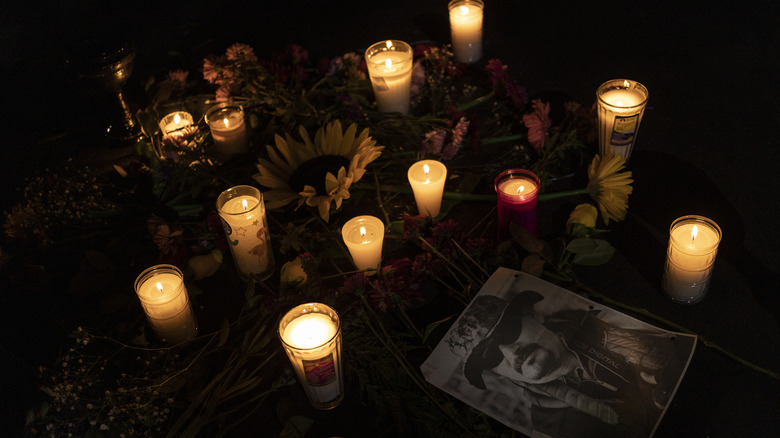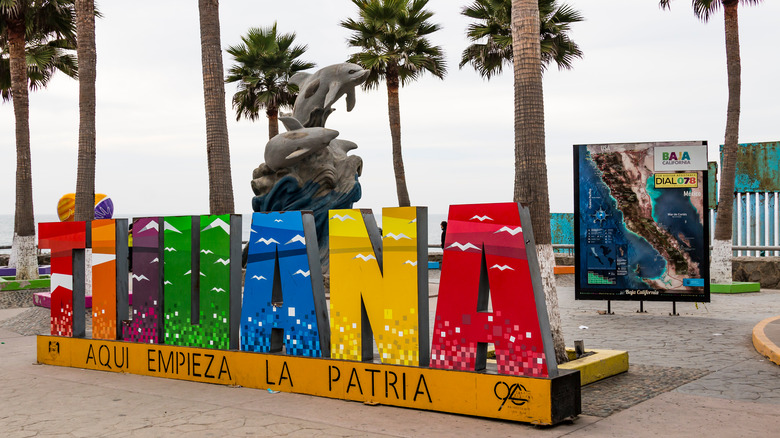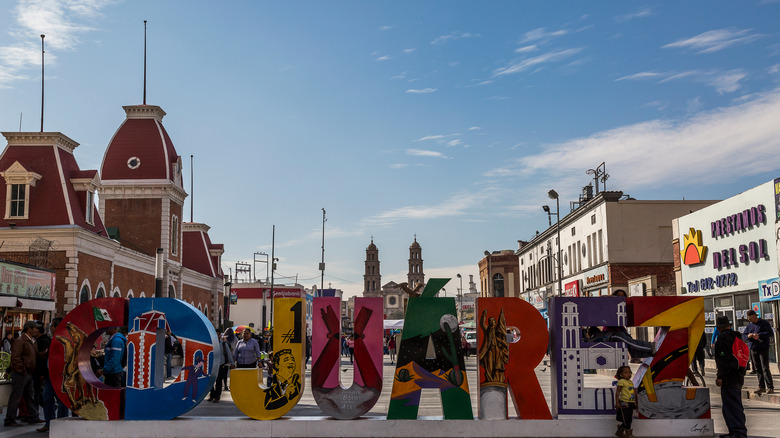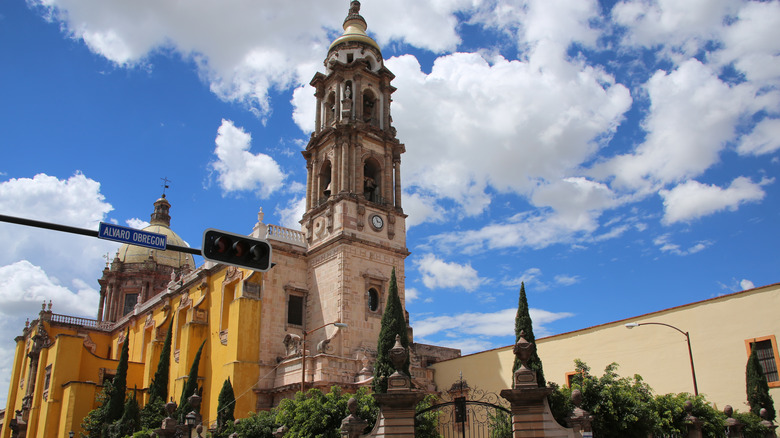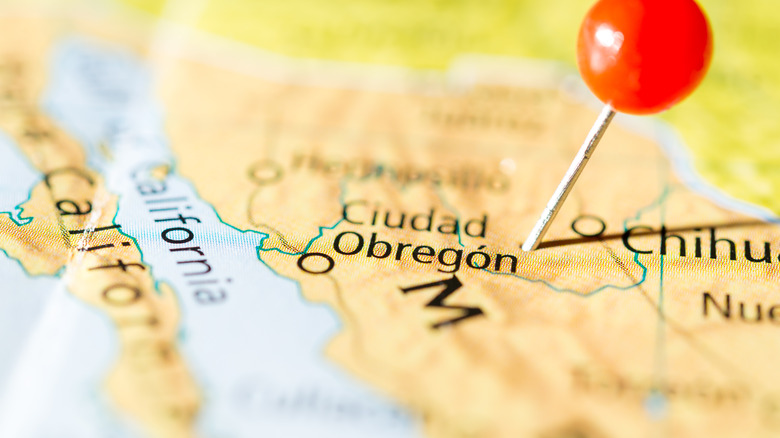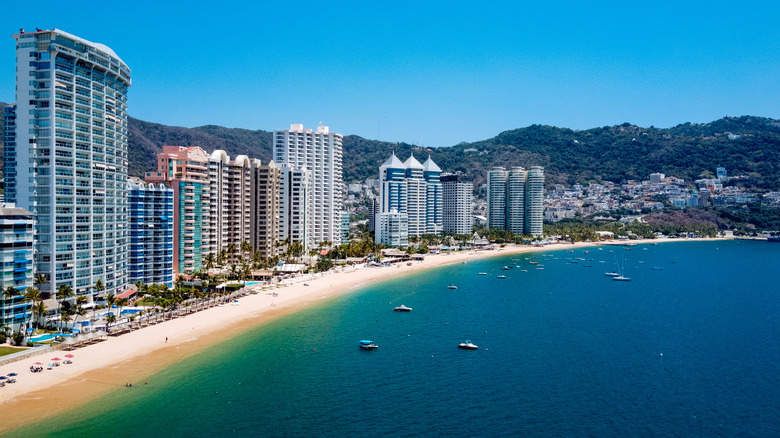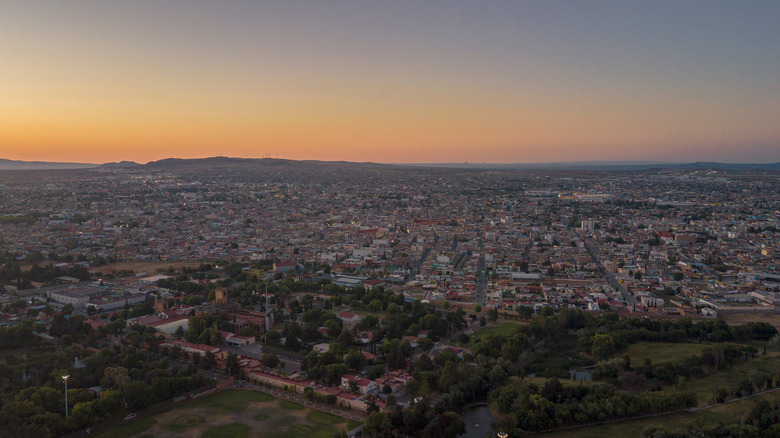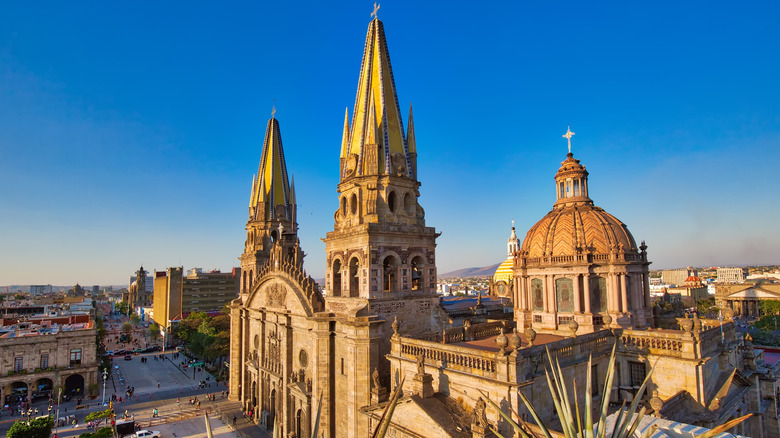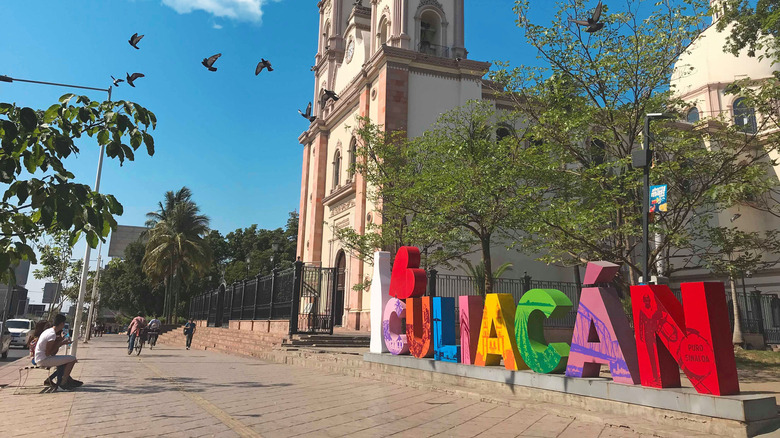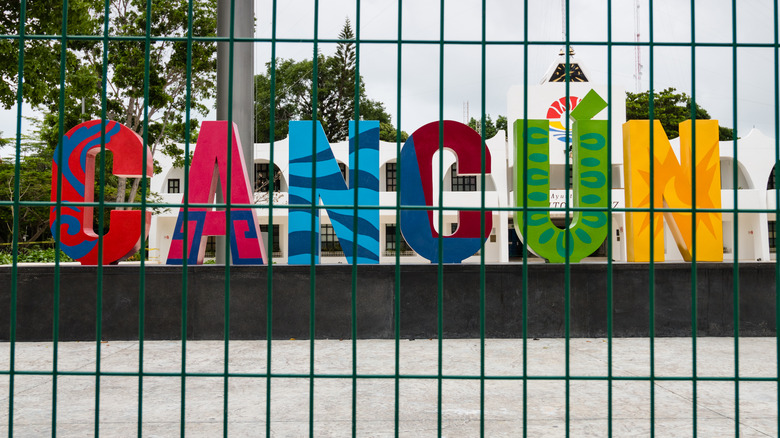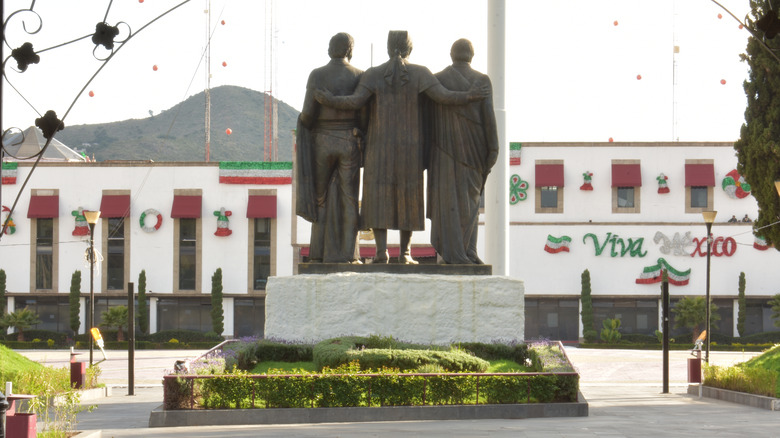The Most Dangerous Cities In Mexico
When it comes to violence, some Mexican cities are more notorious than others, with homicide rates steeply rising in the past years.
When president Andrés Manuel López Obrador (AMLO) took over the presidency in 2018, he promised to reduce the levels of violence in the country, which was going through the most violent year in history. Following years of heavily armed conflicts between criminal gangs and military forces, the country was counting the bodies of innocent bystanders. AMLO affirmed the dark days are over, only to experience the worst first year of any Mexican president ever when it came to murder rates — 34.582 murders in a year (via Insight Crime). The homicide numbers reached new heights after 2020, plummeting the country deeper in despair, and AMLO's plan to tackle impunity and corruption in institutional forces as well as demilitarize Mexican cities — through the newly established National Guard and "hugs not bullets cartel policy" — did not go according to plan.
Mexico faces a rise in numbers of femicide in recent years as well, reports Natalie Gallón for CNN. In 2019, the number of femicides rose by more than 10%, with the pandemic crisis further exacerbating the situation. While Mexican women demand stricter implementation of the existing laws around gender-based violence, AMLO is continuously denying the problem, claiming that 90 percent of the emergency calls reporting on violence targeting women are false. Here is the list of the most dangerous cities in Mexico explained.
Tijuana, Baja California
As of 2020, Baja California state was leading the statistics as the least peaceful Mexican state for the third year in a row. According to the 2021 Mexico Peace Index report, conducted by the Institute for Economics & Peace, more than half of killings in Mexico took place in only six states — one of them was Baja California. The state also ranked as one of those in which peacefulness deteriorated the most in the recent years, and it has seen a massive escalation in homicide, firearms crime, organized crime, and violent car robberies. But delving deeper into Baja California, Tijuana is also infamous as one of the most dangerous cities in the world, with a homicide rate 20 times higher than the global average.
As explained by Laura Calderón in Voice of San Diego, course leader at the University of San Diego, the main reason for high levels of violence in the area is drug trafficking and drug production, which is closely connected to gang activity. Several gangs — the Sinaloa cartel, the Arellano Felix cartel, the Jalisco New Generation Cartel, and others — have been fighting for dominance, alongside the smaller drug dealers: "They're not only fighting for major plazas and smuggling routes, but they're also fighting for corners," reports Calderón.
Tijuana can also be fatal not only for the civilians, but for journalists as well. Of the five journalists killed in the first five weeks of 2022, three of them lost their lives in Tijuana (via Mexico Daily Post).
Juárez, Chihuahua
Chihuahua is another border state where violence is steeply rising, following Baja California as one of the most dangerous states in Mexico, according to the 2021 Mexico Peace Index report. The peace index has been falling since 2015, with the city of Juárez taking the second place on the list of most violent cities in the world.
Statistics show a 15% rise in homicides in the first half of 2020 in Juárez alone, reports Daniel Borunda for El Paso Times. According to authorities, the main reason for the spread of violence is drug related activity, with the local gangs fighting for their shares in the crystal methamphetamine business. The fragmentation of bigger cartels, such is infamous Juárez cartel, led to many changes in organizations, with the new ones emerging from the previously existing cartels: "As they have the same origins, these crime organizations — let's remember that at one time they worked together, worked united — they know each other perfectly ... They know where they (rivals) are and that makes it easier for them to act against each of them," explained Chihuahua Attorney General César Peniche Espejel.
Juárez was also the hotspot from which the protests against femicide in Mexico emerged, after a local artist and social activist, Isabel Cabanillas, was killed in 2018. Demanding justice for Cabanillas, demonstrators drew attention to the fact that Isabel was a well-known fighter for women's rights, which could be the reason behind her murder (via El Paso Times).
Celaya, Guanajuato
Celaya, the third biggest city in the state of Guanajuato, has fallen victim to Santa Rosa de Lima Cartel (SRLC) and their ongoing battles with the Jalisco New Generation Cartel (JNGC), accompanied by SRLC's internal battles for control. After a police raid in June 2020, following AMLO's determination to close down the fuel thefts, the SRLC's gang leader threatened "to blow up" the government, reports BBC. Only two months later, the SRLC's gang leader was finally arrested, according to The Guardian. The case could serve as the great example of victory for AMLO, since slashing the homicide rates in the region would affect the whole Mexico: "If you can cut Guanajuato's murders in half you can bring down the nationwide levels of violence by 7% or 8%," explained security specialist Eduardo Guerrero.
As per the 2021 Mexico Peace Index report, Guanajuato state overall saw the highest number of police homicides in the country in 2020. While violence against politicians and security forces is on the rise all over Mexico, there were nine political assassinations in Guanajuato. The organized crime rate grew by 54.5% — the second biggest increase in any Mexican state.
With the proximity of the biggest oil refinery in Salamanca, surrounding cities also thrive from illegal fuel theft racketeering, including the city of Irapuato, which is classified as the city with the fourth highest homicide rate in the country. The local CSRL cartel is not only focusing on fentanyl, but also stealing oil directly from pipelines in the area.
Ciudad Obregón, Sonora
According to Security Secretary Rosa Icela Rodríguez, the city of Ciudad Obregón is in Cajeme — one of the 15 municipalities in Mexico which accounts for at least a quarter of murders in the country. 2020 was especially deadly for the local residents, with an almost 50% rise in homicides. Ciudad Obregón was also declared the fourth most dangerous city in the world (via Frontera Desk).
According to the 2021 Mexico Peace Index report, the whole region around Ciudad Obregón, Sonora, saw the biggest deterioration of peace in recent years. Neighboring Guanajuato and San Luis Potosi, the whole area is subjected to rising levels of violence, a consequence of cartel wars over the thriving fentanyl business. While the majority of the country saw an increase in peacefulness during the COVID-19 lockdowns in 2020, Sonora was not one of those areas, as the state saw one of the biggest deteriorations of peace in Mexico. Besides crime violence, Sonora also saw the second biggest rise in domestic violence in the country, with 50% more cases in a year.
As explained by Beltran Leyva Org for Insight Crime, the rise of the violence in Ciudad Obregón and wider region is closely connected to in-house conflicts inside the Sinaloa Cartel, as well as their continuous war with the Jalisco Cartel New Generation and other gangs. The close proximity of the U.S. and maritime access to the Pacific make the region perfect for drug, arms, and human trafficking, while gold mines in the area offer other opportunities.
Acapulco, Guerrero
The Guerrero region has seen a large improvement in peacefulness in 2020, as per the 2021 Mexico Peace Index report, but only due to the previous levels having reached extreme heights since 2015. There were less cases of armed clashes between rival gangs after 2018, and the COVID-19 pandemic period helped to further curb the numbers. While the report shows improvement in the area of organised and violent crime, including extortions and kidnappings, there is a substantial increase in domestic violence and sexual assault. Drug related crimes are on the rise, similar to in other regions of the country.
There is no dominant cartel in Guerrero, but around 40 smaller groups, which is the most in any state. Half of these groups are proper criminal organizations, focusing their business on the distribution and production of heroin. With a massive space for poppy growing, the Guerrero region is the head supplier of heroin to the USA.
As explained by Joshua Partlow for The Washington Post, Acapulco's violent recent past started in 2007, when the dominant cartel split and left a substantial market to fill. The local, smaller groups started to "freelance" for bigger cartels from the other states, specializing on specific crimes. This "wheel network" of gangsters is less prone to information leaks and don't operate on personal connections, which makes them even more deadly, clarifies scholar Cecilia Farfán.
Fresnillo, Zacatecas
Living in Fresnillo is like living in hell, according to the local citizens, writes Oscar Lopez for The New York Times. Explosions, killings, and kidnappings are a part of daily life in a city, where almost everyone — a staggering 96% of the population — feels unsafe: "'Hugs not bullets' doesn't work ... We're losing the ability to be shocked," complained Javier Torres Rodríguez, a brother of a victim. More and more people are afraid to leave the house, although this doesn't solve much — many attacks take place in people's homes, forcefully invaded by perpetrators.
The area around Fresnillo — the Zacatecas region — saw the biggest deterioration in peacefulness in 2020, confirms the 2021 Mexico Peace Index report. The state borders the San Luis Potosi and Guanajuato regions, which face similar conditions: namely, violence over drug trafficking. The increased use of fentanyl is causing violent clashes between national drug cartels, who fight for influence and power in the area. The region's highway connections with the U.S. and Colima port make it ideal for drug distribution, putting Fresnillo at the center of the fentanyl business.
On top of that, there were already three different cartels operating in the area — the Gulf Cartel, the Northeastern Cartel, and the Talibanes — when two other cartels decided to occupy the area. The first one is the well-known Sinaloa Cartel, expanding from Guadalajara state, and the second is the brutal Jalisco New Generation Cartel, advancing from Jalisco. The latter moved fast and successfully in 2020, even reaching Mexico City.
Guadalajara, Jalisco
Guadalajara's history is closely connected to the cocaine and marijuana business in the 1980s, turning into a methamphetamine hot spot in the 2000s and gaining the informal title of "Chemical City," report Analy Nuño and Tom Phillips for The Guardian. It has a long history of cartel business as well — after a murder of the significant Sinaloa Cartel member in the heart of Guadalajara in 2010, Cartel Jalisco Nueva Generación (the Jalisco New Generation Cartel) was born, soon becoming one of the most violent gangs in the country. Presenting a national security threat and frequently attacking public officials, the cartel mostly operates in the Jalisco mountains, where they have their training and production facilities.
Despite the cartel's growing power across Mexico, internal disputes and ongoing war with local Santa Rosa de Lima often result in mass killings. The situation in Guadalajara reached a critical point in 2020; there were so many homicides in the city but no space in a local morgue, so they had to keep the bodies in refrigerated trucks, explains Mark Stevenson for ABC News. However, the Guadalajara residents, used to gang violence, say that they "prefer" Jalisco New Generation Cartel's organized ways of operating, since they don't target civilians, but focus on their drug business instead. But, as head security official Sofia Huett explains, all this is just good PR: "This propaganda doesn't just seek to intimidate rivals, but the whole population, as well. I would even say there may be political goals behind these types of messages."
Uruapan, Michoacán
Michoacán is one of the six states, which, according to The Mexican Peace Index report 2020, together reported more than half of the homicides that took place in the whole country. It is also one of the states where the citizens have seen the biggest deterioration in security and peace, regularly observing violent clashes between gangs and authorities. Uruapan, the second largest city in the area, ranked third on the list of the world's most violent cities. The cause of violence is mostly the Jalisco New Generation Cartel, trying to dominate more than 20 local groups, mostly operating Pacific trafficking routes and chemical drug businesses. But, due to a decline in heroin demand, gangs had to look elsewhere to create profit. The nearby avocado farmers became the latest target, with at least four gangs participating in avocado business extortion.
But, as reported by BBC, any attempts by authorities to arrest or detain a gang member mostly result in more killings. Uruapan is often a scene of brutal, war-like violence — in February 2020, after the arrest of a leader of one of the local gangs, Los Viagra, members of the gang blocked roads with burning vehicles and shot at the police forces. The latter is nothing new, since cartels often target military and police officers. Public displays of assaults are also common, with citizens regularly being exposed to disturbing scenes.
Culiacán, Sinaloa
Sinaloa experienced an improvement in peacefulness in recent years, recording the biggest downfall in homicide rates since 2018, along with a decline in armed conflicts in the state. According to the 2021 Mexico Peace Index report, the prevalence of organized crime fell by 55.3%, including a 72.6% drop in drug crimes and a 55.1% drop in extortions, as a consequence of fruitful collaboration between the state and municipal police forces.
But this increase in safety did not come without a cost, explain Josue David Piña and Marcos Vizacarra for Insight Crime. The city of Culiacán is well known as the headquarters of the Sinaloa Cartel, one of the most notorious gangs in the world. The city is far from being immune to its criminal powers, as it became obvious in October 2019, when gang members took hostage of the city. The attack was a response to the detention of Ovidio Guzmán López, the son of the founder of the Sinaloa Cartel. López was released soon after as the authorities tried to minimize the consequences of the attack, which only deepened the wide disparity between political promises and action. The community did not forget: "The cordial relationship that had existed between civil society and the Cartel was undermined. It didn't break, but it suffered serious cracks. I think that a significant part of civil society took the path of saying, 'We don't need this group in Sinaloa anymore,'" explained a sociologist from Sinaloa, Tomás Guevara Martínez.
Cancún, Quintana Roo
The famous Caribbean tourist mecca became a no-go zone by the end of 2021, with AMLO sending a "Tourist Battalion" — 1500 National Guard soldiers, to keep the piece in the area — reports the National Post. Cancún and surrounding cities — such as Playa del Carmen, Tulum, and Puerto Morelos — have all seen armed clashes in public places, including hotels, restaurants, and nightclubs. Several tourists were killed in gang related crossfires: "What we're seeing is a huge increase in street fighting from the plaza bosses. That's how they respond when rivals come onto their turf. They don't lose any sleep over who they shoot. And if there are innocent bystanders, too bad. That's the way they think," explained cartel expert Robert Almonte (via the New York Post).
In Cancún, the latest tactic by security forces is the Beach Reinforcement program, expanding the patrolling powers of the city. Part of the program includes patrolling police officers riding on four wheelers and monitoring the Cancún Hotel Zone beaches. Random inspections are carried out on beachgoers to prevent criminal activities, according to Cancún News.
That said, per the 2021 Mexico Peace Index report, the surrounding region of Quintana Roo state has seen the biggest increase in safety, with firearms crime rates declining for more than a third. Cases of robbery and family violence became less frequent. The area also recorded less homicides then in previous years. The COVID-19 lockdowns also affected big parts of the drug business — easy connections to ports and general mobility.
Ecatepec de Morelos, México
According to Beltran Leyva Org for Insight Crime, Ecatepec is the dark secret of the otherwise quite stellar reputation of Mexico City. Smaller, local gangs dominate the area, with bigger organizations, such as Familia Michoacana and Beltrán Leyva Organization (BLO), being involved in predominantly drug business. Conflict between groups, fighting for extortion parts or drug markets, has led to a series of killings, including civilians, including 20 business owners.
Ecatepec has also earned itself the eerie title of "women's dumping ground" after numerous bodies and body parts of teenage girls have been found in the area. The authorities were often reluctant to research these cases, as in other cases of femicide in the country. In one case, Barbara Reyes' parents tried to learn the truth about their daughter's body for 18 months — in reality, it was found two months after her suspicious disappearance and dumped in a mass grave by the officials. The family wasn't notified, and the case was never investigated, report Anahi Rama and Lizbeth Diaz for Reuters.
